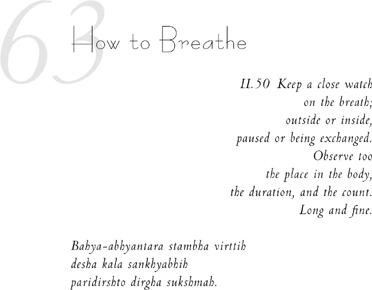

So the breath is connected to the inner winds, which are linked to our very thoughts. This means that if we keep a close eye on our breath—both during our yoga exercises and throughout the day as well—then we can monitor the state of our mind and the condition of those two troublesome side channels.
If you think about it, breath can be in three places: all breathed out, when it pauses momentarily; all breathed in—again a pause; or moving between these two states.
In meditation, in a yoga pose, and with the boss at work we strive to keep our breaths long and slow, with a constant even inflow and exhale. This keeps the inner winds calm and thus our mind clear and focused.
When we're nervous or upset, inhales tend to go much quicker than exhales. We correct this by mentally counting the seconds for each, until inhales and exhales take equal time. Then extend the calm exhales further.
Since the inner winds are tied to our thoughts, with proper training we can also mentally direct a certain number of breaths through specific inner blockages, and then the inner winds will follow.